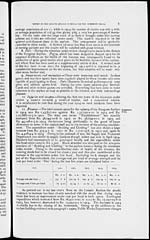Medicine - Mental health > 1907-1924 - Note on the lunatic asylums in Burma > 1907-1921 - Lunatic asylums Burma 1907-21 > 1912-1914 - Note on the lunatic asylums in Burma for the triennium 1912-14
(188) Page 2
Download files
Individual page:
Thumbnail gallery: Grid view | List view

2 REPORT ON THE LUNATIC ASYLUMS IN BURMA FOR THE TRIENNIUM 1912—14.
continued throughout the triennium with satisfactory results. The coating of
latrine receptacles with " Navy fuel " is reported to be more cleanly and more
efficient than with coal-tar which it has replaced. The personal cleanliness of
inmates has received closer attention and their wearing apparel boiled and cleaned
regularly.
5. Employment and treatment.—Inmates capable of work are given suitable
employment in gardening, weaving, paddy-grinding, rope-making, tailoring and in
general cleaning of the premises. In order to improve the health of inmates in
Rangoon the coir pounding and weaving sheds were closed in 1913, and as far as
possible all inmates were allowed out-door occupations. As health conditions
improved weaving was recommenced and at the close of the year, five looms were
in constant use.
Since the beginning of the year 1914 Major Sargent, I.M.S., the Superin-
tendent of the Rangoon Asylum, has introduced with my approval a system under
which every patient, on admission, is provided with a medical history sheet, and
kept in hospital under the personal observation of the Superintendent until his
condition is determined as chronic or otherwise. If deemed to be a chronic case,
he is passed on to various sections, where he is weighed twice a month and notes
as may be found necessary are made as to his mental condition—the usual period
for a note being every three months. Special notes of relapses, change of labour,
etc., are made as they occur. Under these arrangements it is found to be quite
easy to ascertain whether or not the health of any patient is being improved and
to alter labour, diet or treatment as considered necessary. At the Minbu Asylum
in addition to the use of sedatives for excited cases, selected cases were treated
with iodides and with tonics generally with benefit.
Statements
I & II.
6. Sickness and mortality.—The daily average sick at Rangoon, which
increased slightly from 41.56 in 1912 to 42.81 in 1913 has shown a great rise to
111.02 in 1914. The reason is that all convalescent and special gangs were dis-
continued and the introduction of the system, sketched in the foregoing paragraph,
whereby patients on admission are sent into hospital and kept there as long as any
special attention is found to be needed. In Minbu, the health of the inmates
remained satisfactory and the death rate percentage of daily average strength
has fallen from 3.42 in 1912 to 2.69 in 1913 and to 0.96 in 1914. In
Rangoon the general health of the inmates has shown great improve-
ment. The percentage of mortality works out at 7.20 in 1914 against
19.95 in 1913 and 31.29 in 1912. In considering the mortality and other
statistics of this asylum, Major Sargent considers that the criminal and civil
population should be dealt with separately. The average percentage of mortality
in the asylum for the last 29 years was found to be 7.10 among the criminal
and 13.65 among the civil insanes. The figures for 1914 are 6.77 criminal and
7.43 civil. The figures for the civil are the lowest for the 29 years, while the
criminal mortality is high. This latter, Major Sargent considers to be somewhat
abnormal, for 2 of the patients who died from dysentery were admitted suffering
from the disease. Although the mortality has been high yet the general health
of the criminal population has been very good. Taking however the triennium as
a whole the mortality figures in Rangoon are very high with a yearly average of
19.48 and compare most unfavourably with that of the previous triennium, which
was only 10.06. The three great sources of danger in the asylum are pneumonia,
tubercle, and dysentery and these accounted for 10 out of 34 deaths in 1914. As
up-to-date sanitary arrangements are absent, dysentery presents itself almost
constantly and there is always a danger of a serious outbreak occurring. The
mortality of the two asylums, which rose from 8.10 in 1909 to 11.43 in 1911 in the
previous triennium has again shown an increase to 25.78 in 1912, but fell to 16.50
in 1913 and to 6.08 in 1914.
7. Nursing scheme.—-Since September 1914, the nursing scheme sanctioned
by Government has been brought into force in the main asylum. The Matron with
her three nurses assisted by 19 recovered insanes were employed on this work.
The result is very encouraging. The health of the female yard compares favourably
with any English asylum. The female and male population live under exactly the
same conditions. In the female yard there were 7 deaths in 1913 with a total
Set display mode to: Large image | Zoom image | Transcription
Images and transcriptions on this page, including medium image downloads, may be used under the Creative Commons Attribution 4.0 International Licence unless otherwise stated. ![]()
| India Papers > Medicine - Mental health > Note on the lunatic asylums in Burma > Lunatic asylums Burma 1907-21 > Note on the lunatic asylums in Burma for the triennium 1912-14 > (188) Page 2 |
|---|
| Permanent URL | https://digital.nls.uk/83980538 |
|---|



![[Page 1]](https://deriv.nls.uk/dcn4/8398/83980537.4.jpg)
